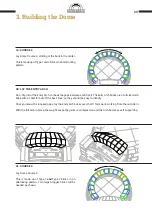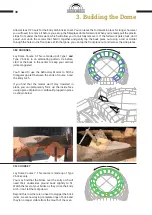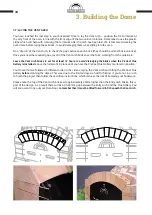
42
9. Curing the Oven
Curing the Oven
CURING THE OVEN
Regardless of the weather conditions during your build, when you are finished your oven will still be holding
water. Each brick was soaked before being laid, so your oven will be holding water in the walls, floor and CalSil
board. If you lit a large fire in the oven now, this water will vaporise and cause significant damage! You need to
slowly dry the oven out, or ‘cure’ it before you start lighting serious fires.
Before you start your curing fires, you
need to wait long enough to allow all of the refractory materials to set properly before getting heat into them.
THE SEVEN AND TWO RULE
Your Refractory Mortar needs to set for at least
7 days
before you light the first curing fire.
Your Perlite Render needs to set for at least
2 days
before you light the first curing fire.
EXAMPLE 1:
You’re an oven building machine, and you complete the dome bricks, insulation and render
all on the same day
.
You would then wait for 7 days, giving the mortar and the render both enough time to set.
EXAMPLE 2:
You build the oven at a more enjoyable pace; you completed the brickwork two weeks ago, and just today
you’ve put your final coat of Perlite render on. You would now only have to wait for 2 days, as the mortar has
already had plenty of time to set good and hard, you just need to allow the render time to set.
Before you light your first curing fire, clean the stainless steel flue to remove any marks or fingerprints left on
it from installation. Use a solvent such as methylated spirits, thinners, acetone or rubbing alcohol to wipe the
surface down, then wash with soapy water before drying with a soft cloth.
** It is critical that you watch the instructional video that we’ve made for Curing your Oven. While it’s not rocket
surgery, it’s something that is much more easily communicated by video than in these written instructions.
Head to our website or YouTube channel to find this video, which takes you through the process.
CRACKING
Please note that it is completely normal to see some hairline cracking in your oven, in fact we can guarantee
that you will! This is because you’re heating up a rigid, ceramic structure to extremely high temperatures,
which creates thermal stress in the brickwork. To relieve this stress, the oven will develop several small cracks,
usually around 1mm in width. It’s common to see a crack starting at the base of the dome that runs all the
way up to the keystone, as well as some fine cracks in the mortar joints of the Vent Arch, and around the Flue
Gallery. You’ll also see some cracks in the Perlite Render radiating from the junction with the Flue Gallery.
Don’t let these cracks concern you at all. You should be expecting them. This cracking is normal and there’s
nothing that you can do to prevent it. Cracking is and always has been a part of owning a Wood Fired Oven.
What’s important to know is that they won’t get worse over time, they’re just there as thermal stress relief.
If you get a large crack in your mortar (over 2mm width) then we have repair materials that can be sent out to
you, however this is rare, and is usually due to the oven being over-fired early in the curing stages. Any cracking
in the Perlite render will be covered by the roll-on acrylic coating that you’ll apply once the oven is fully cured.
Содержание D95
Страница 1: ...D95 Brick Oven D95 PRECUT BRICK OVEN KIT Instruction Booklet ...
Страница 44: ...44 Examples ...
Страница 45: ...45 Examples ...






































